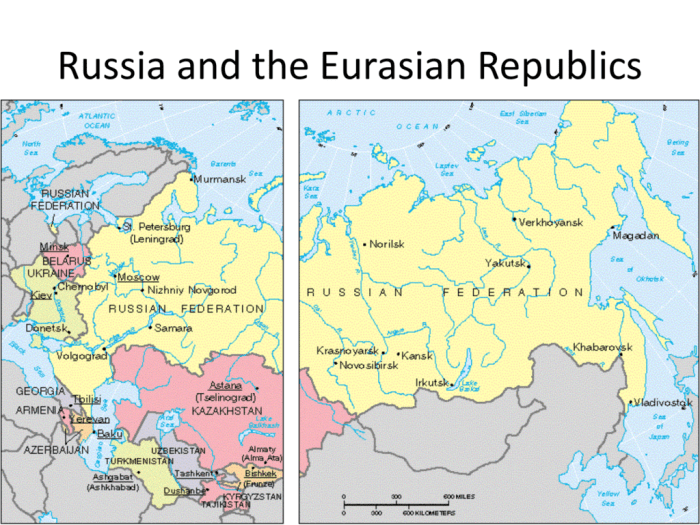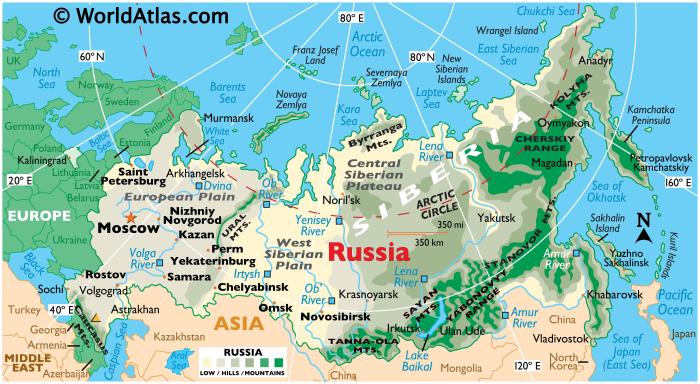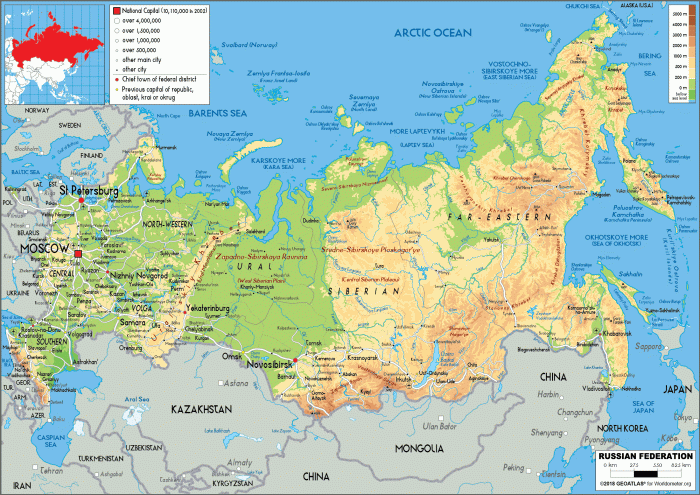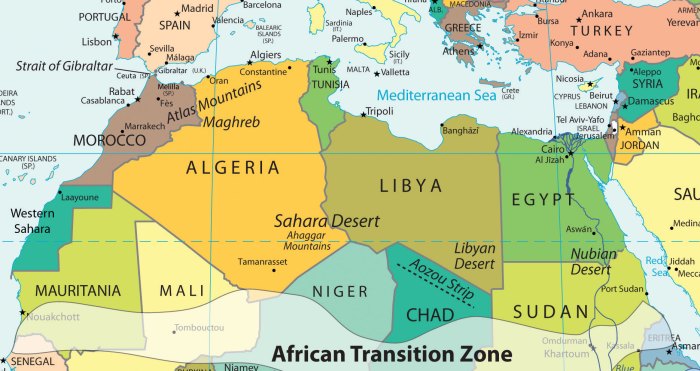The Russia and Republics Physical Map presents a comprehensive overview of the vast and diverse terrain that defines Russia and its constituent republics. This map serves as an invaluable resource for understanding the geographical complexities of this expansive region, showcasing its major rivers, mountain ranges, lakes, and other prominent natural features.
By examining the physical map, we gain insights into the topography, climate, vegetation, and natural resources that shape the landscape of Russia and its republics.
The map provides a detailed visual representation of the region’s physical attributes, allowing us to explore the intricate relationships between geography and the natural environment. It serves as a valuable tool for geographers, historians, environmentalists, and anyone interested in understanding the physical characteristics of Russia and its republics.
Physical Map of Russia and its Republics
The physical map of Russia and its republics provides a comprehensive overview of the region’s geographical features. The map highlights major rivers, including the Volga, Ob, and Yenisei, as well as mountain ranges such as the Ural Mountains, Caucasus Mountains, and Altai Mountains.
The map also shows major lakes, including Lake Baikal, the largest freshwater lake in the world.
The legend on the map explains the symbols and colors used to represent different geographical features. The map is an essential resource for understanding the physical geography of Russia and its republics.
Topography of Russia and its Republics
Russia and its republics exhibit a diverse topography. The region is home to vast plains, including the West Siberian Plain and the East European Plain, as well as high mountain ranges, such as the Ural Mountains and the Caucasus Mountains.
The topography of the region is influenced by a variety of factors, including tectonic activity, climate, and erosion.
Major Mountain Ranges
- Ural Mountains
- Caucasus Mountains
- Altai Mountains
Major Plains
- West Siberian Plain
- East European Plain
Major Plateaus
- Central Siberian Plateau
- East Siberian Plateau
The topography of Russia and its republics has a significant impact on the region’s climate and vegetation. The high mountain ranges act as barriers to air flow, creating distinct climate zones. The plains are home to a variety of vegetation types, including forests, grasslands, and tundra.
Climate of Russia and its Republics

The climate of Russia and its republics is highly diverse, ranging from subarctic in the north to subtropical in the south. The region experiences a wide range of temperatures, with average winter temperatures below freezing in most areas and average summer temperatures above freezing.
Precipitation varies greatly across the region, with some areas receiving as little as 200 mm per year and others receiving over 1,000 mm per year.
Climate Zones
- Subarctic
- Temperate
- Continental
- Subtropical
The climate of Russia and its republics is influenced by a variety of factors, including latitude, altitude, and distance from the ocean. The region’s climate is also affected by the North Atlantic Oscillation, a climate pattern that affects the strength and direction of the jet stream.
Vegetation of Russia and its Republics

The vegetation of Russia and its republics is diverse, ranging from tundra in the north to desert in the south. The region is home to a variety of vegetation types, including forests, grasslands, and wetlands. The vegetation of the region is influenced by a variety of factors, including climate, soil, and topography.
Major Vegetation Zones
- Tundra
- Taiga
- Temperate Forest
- Steppe
- Desert
The vegetation of Russia and its republics provides a variety of benefits, including timber, food, and shelter. The region’s vegetation is also important for regulating the climate and protecting water resources.
Natural Resources of Russia and its Republics

Russia and its republics are rich in natural resources, including oil, gas, coal, and minerals. The region is one of the world’s leading producers of oil and gas, and it also has significant reserves of coal and minerals. The natural resources of the region are an important source of economic revenue.
Major Natural Resources, Russia and republics physical map
- Oil
- Gas
- Coal
- Minerals
The natural resources of Russia and its republics are distributed unevenly across the region. The oil and gas reserves are concentrated in the western part of the region, while the coal and mineral reserves are located in the eastern part of the region.
Administrative Divisions of Russia and its Republics: Russia And Republics Physical Map
Russia is divided into 85 federal subjects, which include 22 republics, 46 oblasts, 9 krais, 3 federal cities, 1 autonomous oblast, and 4 autonomous okrugs. The republics are the most autonomous of the federal subjects, and they have their own constitutions and governments.
The following table lists the administrative divisions of Russia and their capitals:
| Federal Subject | Capital |
|---|---|
| Adygea Republic | Maykop |
| Altai Republic | Gorno-Altaysk |
| Bashkortostan Republic | Ufa |
| Buryatia Republic | Ulan-Ude |
| Chechnya Republic | Grozny |
Top FAQs
What is the largest mountain range in Russia?
Ural Mountains
What is the largest lake in Russia?
Lake Baikal
What is the longest river in Russia?
Ob River
